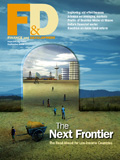 View this Issue Archive of F&D Issues Subscribe to Print Edition Write to us F&D welcomes comments and brief letters, a selection of which are posted under Letters to the Editor. Letters may be edited. Please send your letters to: fanddletters@imf.org. F&D Magazine Free Email Notification Receive emails when we post new
items of interest to you. |
A turning point for the world's poor Many of the world's low-income countries are again having to make tough policy choices. With food and oil prices touching record highs and global growth on a down trend, countries battling to reduce poverty levels need to juggle to curb inflation, while maintaining growth and social spending. The downturn comes at a time when things were starting to look better for low-income countries, particularly in sub-Saharan Africa, where some economies are now successfully attracting international investors and are seen as a new tier of "frontier" emerging markets (see David Nellor's article in this issue). So the new, and the not-so-new, hurdles faced by low-income countries make it even more critical for advanced economies and other donors to live up to their commitments on aid levels and keep working closely with recipient countries to improve aid quality. At a series of prominent meetings in 2008—the Accra High Level Forum on Aid Effectiveness on September 2-4, the UN Summit on the Millennium Development Goals in New York in late September, and the Financing for Development follow-up meeting in Doha in November, among others—a broad array of stakeholders will work toward building consensus and strengthening aid (and development) effectiveness. Alongside aid, it is also critical to move further on opening up major country markets for exports from low-income countries, as well as giving them help to exploit trading opportunities in an increasingly integrated global economy. This edition of Finance & Development examines key issues facing low-income countries today. Masood Ahmed's overview identifies four major macroeconomic challenges that low-income countries are grappling with and outlines possible approaches to tackle them. Three articles explore emerging trends, and problems, in the aid business and how to transform the governance of aid. Eckhard Deutscher and Sara Fyson of the OECD examine the changing landscape of donors and find that aid fragmentation poses a major problem, with a proliferation of donors straining the government apparatus of some smaller countries. Aid unpredictability is another major difficulty, say Oya Celasun and Jan Walliser. It prevents countries from making full and good use of the money. The 2005 Paris Declaration on Aid Effectiveness is a dynamic, action-oriented road map that attempts to remedy these and other problems in the delivery of aid, Elaine Venter reminds us, but it still remains donor-centric. Other articles in this issue include an account by Eswar S. Prasad and Raghuram G. Rajan of their new report on financial sector reforms in India; Martin Ravallion and Dominique van de Walle draw lessons on reducing poverty from Vietnam's agrarian reforms; Sanjeev Gupta and Shamsuddin Tareq make a strong case for sub-Saharan countries to mobilize their domestic revenue bases. In addition, Simon Willson profiles Beatrice Weder di Mauro, the first woman on Germany's Council of Economic Experts; and the outgoing IMF Chief Economist Simon Johnson tells us that the new drivers of global growth—emerging markets—will have to fight inflation successfully to prevent future crises. Jeremy Clift |